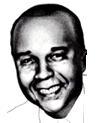Percy Julian
Born in Montgomery, Alabama in 1899, Percy Lavon Julian, the grandson of a former slave, overcame a lifetime of discrimination by becoming an internationally acclaimed inventor of synthetic (man-made) medicines.
In spite of the minimal elementary education offered to blacks in Alabama in the early 20th century, Julian enrolled in DePauw University in Greencastle, Indiana, and graduated in 1920 as the class valedictorian. He then earned a master's degree from Harvard in 1923 and a PhD in organic chemistry from the University of Vienna in 1931. Returning to DePauw, Julian achieved his first breakthrough in 1935 when he created physostigmine, a drug made from the calamar bean that was used to fight the potentially blinding eye disease, glaucoma.
Later in life, Julian succeeded in synthesizing the male and female hormones testosterone and progesterone using sterols (solid alcohol compounds) extracted from soybean oil. But Julian is best known for his synthesis of cortisone, which is used to combat arthritis and other ailments of the limbs and joints. Until Julian's invention ("Preparation of Cortisone," patent #2,752,339), cortisone had to be extracted in natural form from the adrenal glands of oxen and cost hundreds of dollars per drop. Now, thanks to Julian, cortisone is readily available and costs only pennies per ounce.
Julian also invented outside the realm of medicine. For example, during World War II, he used soya proteins to create "AeroFoam," which extinguished gasoline and oil fires. He will be best remembered, however, as an inventor who used science to make essential medicines available and affordable – a tradition that is carried on today by inventors such as Drs. Herbert Boyer and Stanley Cohen with their synthetic insulin. Moreover, Percy Julian's talent and determination made him both a social and a scientific pioneer.
He died of liver cancer in 1975 at the age of 76.


